Fresh and Hardened Properties of Concrete Reinforced with Basalt Macro-Fibers
Abstract
:1. Introduction
2. Research Significance
3. Materials and Methods
3.1. Materials
3.2. Mixture Proportioning and Testing Methods
4. Results
4.1. Fresh Properties
4.2. Mechanical Properties
4.2.1. Compressive Strength
4.2.2. Splitting Tensile Strength
4.2.3. Flexural Performance
4.3. Durability Properties
4.3.1. Water Absorption
4.3.2. Sorptivity
4.3.3. Abrasion Resistance
4.3.4. Bulk Resistivity
4.3.5. Rapid Chloride Penetration
4.3.6. Ultrasonic Pulse Velocity
5. Discussion
6. Development of Tension Function
6.1. Overview
6.2. Numerical Simulation Model
6.3. Tension Functions
7. Conclusions
- The addition of BMF reduced the concrete workability. Normal- and high-strength concrete mixtures having a similar initial slump exhibited a similar degradation in the workability due to the addition of BMF. At νf of 1.5%, the concrete workability category dropped from high/medium to low/very low.
- The addition of BMF insignificantly improved the compressive strength of the NSC by 1–5%. However, average reductions in the cube and cylinder compressive strengths of 4 and 8%, respectively, were recorded for the HSC reinforced with BMF. The addition of BMF did not result in a noticeable change in the value of f’c/fcu nor the modulus of elasticity of the concrete.
- The improvement in the tensile properties caused by the addition of BMF was more significant for the NSC rather than the HSC. Splitting tensile strength gains of 10, 24, and 52% were recorded for the NSC mixtures at νf of 0.5, 1.0, and 1.5, respectively. Their HSC counterparts exhibited respective splitting tensile strength gains of 3, 10, and 22%.
- The addition of BMF to NSC at νf of 0.5 and 1.0% increased the flexural strength by 18 and 24%, respectively, whereas a significant strength gain of 56% was recorded at the higher νf of 1.5%. The flexural strength of the HSC was improved by the addition of BMF but to a lesser extent, where flexural strength gains of 14, 19, and 25% were recorded at νf of 0.5, 1.0, and 1.5%, respectively.
- The increase in the flexural toughness due to increasing the BMF volume fraction from 0.5 to 1% was almost the same (approx. 39%) for the NSC and HSC mixtures. The NSC mixtures exhibited, however, a more pronounced improvement in the flexural toughness (136%) than that of the HSC (73%), when the BMF volume fraction increased from 0.5 to 1.5%.
- The NSC and HSC with BMF exhibited a comparable reduction in the water absorption of up 12% relative to that of their plain counterparts. The addition of BMF did not change the level of corrosion protection nor the chloride penetrability category of both NSC and HSC mixtures, despite the slight improvement in the bulk resistivity (max. increase of 21%) and the slightly reduced RCPT electrical charges passed through the concrete (max. reduction of 19%). Similarly, the addition of BMF had almost no effect on UPV values of both NSC and HSC.
- The NSC and HSC benchmark specimens exhibited abrasion mass losses of 14.2 and 8.3%, respectively. The addition of BMF to the NSC mixtures reduced the mass loss caused by abrasion by up to 27%. The HSC with BMF exhibited a minor reduction in the abrasion mass loss of up to 4% only.
- New trilinear tensile softening laws that characterize the post-cracking behavior of NSC and HSC reinforced with different BMF volume fractions were established based on an inverse analysis of the flexural test data. A comparison between the load-deflection responses predicted numerically and those obtained from the experiments verified the validity of the tensile softening laws developed in the current study.
Author Contributions
Funding
Institutional Review Board Statement
Informed Consent Statement
Data Availability Statement
Conflicts of Interest
References
- Liu, J.; Jia, Y.; Wang, J. Experimental Study on Mechanical and Durability Properties of Glass and Polypropylene Fiber Reinforced Concrete. Fibers Polym. 2019, 20, 1900–1908. [Google Scholar] [CrossRef]
- Song, P.; Hwang, S.; Sheu, B. Strength Properties of Nylon- and Polypropylene-Fiber-Reinforced Concretes. Cem. Concr. Res. 2005, 35, 1546–1550. [Google Scholar] [CrossRef]
- Yao, Z.; Li, X.; Fu, C.; Xue, W. Mechanical Properties of Polypropylene Macrofiber-Reinforced Concrete. Adv. Mater. Sci. Eng. 2019, 2019, e7590214. [Google Scholar] [CrossRef]
- Elshazli, M.T.; Ramirez, K.; Ibrahim, A.; Badran, M. Mechanical, Durability and Corrosion Properties of Basalt Fiber Concrete. Fibers 2022, 10, 10. [Google Scholar] [CrossRef]
- Gao, J.; Sun, W.; Morino, K. Mechanical Properties of Steel Fiber-Reinforced, High-Strength, Lightweight Concrete. Cem. Concr. Compos. 1997, 19, 307–313. [Google Scholar] [CrossRef]
- Zheng, Y.; Wu, X.; He, G.; Shang, Q.; Xu, J.; Sun, Y. Mechanical Properties of Steel Fiber-Reinforced Concrete by Vibratory Mixing Technology. Adv. Mat. Sci. Eng. 2018, 2018, 9025715. [Google Scholar] [CrossRef]
- Abbass, W.; Khan, M.I.; Mourad, S. Evaluation of Mechanical Properties of Steel Fiber Reinforced Concrete with Different Strengths of Concrete. Constr. Build. Mater. 2018, 168, 556–569. [Google Scholar] [CrossRef]
- Biradar, S.V.; Dileep, M.S.; Gowri, D.T.V. Studies of Concrete Mechanical Properties with Basalt Fibers. IOP Conf. Ser. Mater. Sci. Eng. 2020, 1006, 012031. [Google Scholar] [CrossRef]
- Granju, J.-L.; Ullah Balouch, S. Corrosion of Steel Fibre Reinforced Concrete from the Cracks. Cem. Concr. Res. 2005, 35, 572–577. [Google Scholar] [CrossRef]
- Balouch, S.U.; Forth, J.P.; Granju, J.-L. Surface Corrosion of Steel Fibre Reinforced Concrete. Cem. Concr. Res. 2010, 40, 410–414. [Google Scholar] [CrossRef]
- Wang, Y.; Hughes, P.; Niu, H.; Fan, Y. A New Method to Improve the Properties of Recycled Aggregate Concrete: Composite Addition of Basalt Fiber and Nano-Silica. J. Clean. Prod. 2019, 236, 117602. [Google Scholar] [CrossRef]
- Katkhuda, H.; Shatarat, N. Improving the Mechanical Properties of Recycled Concrete Aggregate Using Chopped Basalt Fibers and Acid Treatment. Constr. Build. Mater. 2017, 140, 328–335. [Google Scholar] [CrossRef]
- Ali, B.; Qureshi, L.A.; Raza, A.; Nawaz, M.A.; Rehman, S.U.; Rashid, M.U. Influence of Glass Fibers on Mechanical Properties of Concrete with Recycled Coarse Aggregates. Civ. Eng. J. 2019, 5, 1007–1019. [Google Scholar] [CrossRef]
- Noushini, A.; Vessalas, K.; Samali, B. Static Mechanical Properties of Polyvinyl Alcohol Fibre Reinforced Concrete (PVA-FRC). Mag. Concr. Res. 2014, 66, 465–483. [Google Scholar] [CrossRef]
- Arslan, M.E. Effects of Basalt and Glass Chopped Fibers Addition on Fracture Energy and Mechanical Properties of Ordinary Concrete: CMOD Measurement. Constr. Build. Mater. 2016, 114, 383–391. [Google Scholar] [CrossRef]
- Ayub, T.; Shafiq, N.; Nuruddin, M.F. Effect of Chopped Basalt Fibers on the Mechanical Properties and Microstructure of High Performance Fiber Reinforced Concrete. Adv. Mater. Sci. Eng. 2014, 2014, 1–14. [Google Scholar] [CrossRef]
- Jalasutram, S.; Sahoo, D.R.; Matsagar, V. Experimental Investigation of the Mechanical Properties of Basalt Fiber-Reinforced Concrete. Struct. Concr. 2017, 18, 292–302. [Google Scholar] [CrossRef]
- Lee, S. Effect of Nylon Fiber Addition on the Performance of Recycled Aggregate Concrete. Appl. Sci. 2019, 9, 767. [Google Scholar] [CrossRef]
- Ali, B.; Qureshi, L.A. Influence of Glass Fibers on Mechanical and Durability Performance of Concrete with Recycled Aggregates. Constr. Build. Mater. 2019, 228, 116783. [Google Scholar] [CrossRef]
- Branston, J.; Das, S.; Kenno, S.Y.; Taylor, C. Mechanical Behaviour of Basalt Fibre Reinforced Concrete. Constr. Build. Mater. 2016, 124, 878–886. [Google Scholar] [CrossRef]
- Das, C.S.; Dey, T.; Dandapat, R.; Mukharjee, B.B.; Kumar, J. Performance Evaluation of Polypropylene Fibre Reinforced Recycled Aggregate Concrete. Constr. Build. Mater. 2018, 189, 649–659. [Google Scholar] [CrossRef]
- Sorelli, L.G.; Meda, A.; Plizzari, G.A. Bending and Uniaxial Tensile Tests on Concrete Reinforced with Hybrid Steel Fibers. J. Mater. Civ. Eng. 2005, 17, 519–527. [Google Scholar] [CrossRef]
- Yoo, D.-Y.; Kang, S.-T.; Yoon, Y.-S. Effect of Fiber Length and Placement Method on Flexural Behavior, Tension-Softening Curve, and Fiber Distribution Characteristics of UHPFRC. Constr. Build. Mater. 2014, 64, 67–81. [Google Scholar] [CrossRef]
- Amin, A.; Foster, S.J.; Muttoni, A. Evaluation of the Tensile Strength of SFRC as Derived from Inverse Analysis of Notched Bending Tests. In Proceedings of the 8th International Conference on Fracture Mechanics of Concrete and Concrete Structures, FraMCoS-8, Ciudad Real, Spain, 10–14 March 2013; University of Castilla-La Mancha: Ciudad Real, Spain, 2013; p. 9. [Google Scholar]
- Fédération Internationale du Béton. Fib Model Code for Concrete Structures; Ernst & Sohn: Lausanne, Switzerland, 2010. [Google Scholar]
- ASTM C150/C150M—19a; Standard Specification for Portland Cement. ASTM International: West Conshohocken, PA, USA, 2012.
- ASTM C127-15; Standard Test Method for Relative Density (Specific Gravity) and Absorption of Coarse Aggregate. ASTM International: West Conshohocken, PA, USA, 2015.
- ASTM C136/C136M-19; Test Method for Sieve Analysis of Fine and Coarse Aggregates. ASTM International: West Conshohocken, PA, USA, 2020.
- ASTM C88/C88M-18; Standard Test Method for Soundness of Aggregates by Use of Sodium Sulfate or Magnesium Sulfate. ASTM International: West Conshohocken, PA, USA, 2018.
- ASTM C131-06; Standard Test Method for Resistance to Degradation of Small-Size Coarse Aggregate by Abrasion and Impact in the Los Angeles Machine. ASTM International: West Conshohocken, PA, USA, 2006.
- ASTM C29/C29M-17a; Test Method for Bulk Density (Unit Weight) and Voids in Aggregate. ASTM International: West Conshohocken, PA, USA, 2017.
- ReforceTech AS, Røyken, Norway. Available online: https://reforcetech.com/ (accessed on 3 December 2020).
- ASTM C31/C31M; Standard Test Practice for Making and Curing Concrete Test Specimens in the Field—ELearning Course. ASTM International: West Conshohocken, PA, USA, 2010.
- ASTM C 143; Test Method for Slump of Hydraulic-Cement Concrete. ASTM International: West Conshohocken, PA, USA, 2012.
- BS EN 12350-4:2019; Testing Fresh Concrete. Degree of Compactability. British Standards: London, UK, 2019.
- BS EN 12350-3:2019; Testing Fresh Concrete. Vebe Test. British Standards: London, UK, 2019.
- BS EN 12390-3:2019; Testing Hardened Concrete. Compressive Strength of Test Specimens. British Standards: London, UK, 2019.
- ASTM C39; Test Method for Compressive Strength of Cylindrical Concrete Specimens. ASTM International: West Conshohocken, PA, USA, 2018.
- ASTM C469-02; Test Method for Static Modulus of Elasticity and Poissons Ratio of Concrete in Compression. ASTM International: West Conshohocken, PA, USA, 2014.
- ASTM C496/C496M-17; Test Method for Splitting Tensile Strength of Cylindrical Concrete Specimens. ASTM International: West Conshohocken, PA, USA, 2017.
- ASTM C1609/C1609M-19a; Test Method for Flexural Performance of Fiber-Reinforced Concrete (Using Beam With Third-Point Loading). ASTM International: West Conshohocken, PA, USA, 2010.
- ASTM C642-21; Standard Test Method for Density, Absorption, and Voids in Hardened Concrete. ASTM International: West Conshohocken, PA, USA, 2006.
- ASTM C1585-20; Standard Test Method for Measurement of Rate of Absorption of Water by Hydraulic-Cement Concretes. ASTM International: West Conshohocken, PA, USA, 2013.
- ASTM C1747/C1747M-13; Test Method for Determining Potential Resistance to Degradation of Pervious Concrete by Impact and Abrasion. ASTM International: West Conshohocken, PA, USA, 2013.
- ASTM C1760; Standard Test Method for Bulk Electrical Resistivity or Bulk Conductivity of Concrete. ASTM International: West Conshohocken, PA, USA, 2012.
- ASTM C1202-17; Standard Test Method for Electrical Indication of Concrete’s Ability to Resist Chloride Ion. ASTM International: West Conshohocken, PA, USA, 2017.
- ASTM C597; Standard Test Method for Pulse Velocity Through Concrete. ASTM International: West Conshohocken, PA, USA, 2016.
- Neville, A.M.; Brooks, J.J. Concrete Technology, 2nd ed.; Pearson: Essex, UK, 2010. [Google Scholar]
- ACI 211.3R-02 R09; Guide for Selecting Proportions for No-Slump Concrete. Americal Concrete Institute: Farmington Hills, MI, USA, 2009.
- ACI 222R 01. Protection of Metals in Concrete Against Corrosion. In ACI Manual for Concrete Practice; Americal Concrete Institute: Farmington Hills, MI, USA, 2008. [Google Scholar]
- Ratay, R.T. Structural Condition Assessment; Wiley: New Jersey, Canada, 2005. [Google Scholar]
- Meyyappan, P.L.; Jemimah Carmichael, M. Studies on Strength Properties of Basalt Fibre Reinforced Concrete. Mater. Today Proc. 2021, 43, 2105–2108. [Google Scholar] [CrossRef]
- Kabay, N. Abrasion Resistance and Fracture Energy of Concretes with Basalt Fiber. Constr. Build. Mater. 2014, 50, 95–101. [Google Scholar] [CrossRef]
- ATENA Computer Software, Cervenka Consulting s.r.o.: Prague, Czech Republic. Available online: https://www.cervenka.cz/products/atena/ (accessed on 21 June 2022).
- Kachouh, N.; El-Maaddawy, T.; El-Hassan, H.; El-Ariss, B. Numerical Modeling of Concrete Deep Beams Made with Recycled Aggregates and Steel Fibers. Buildings 2022, 12, 529. [Google Scholar] [CrossRef]
- Ashour, S.A.; Hasanain, G.S.; Wafa, F.F. Shear Behavior of High-Strength Fiber Reinforced Concrete Beams. Struct. J. 1992, 89, 176–184. [Google Scholar] [CrossRef]
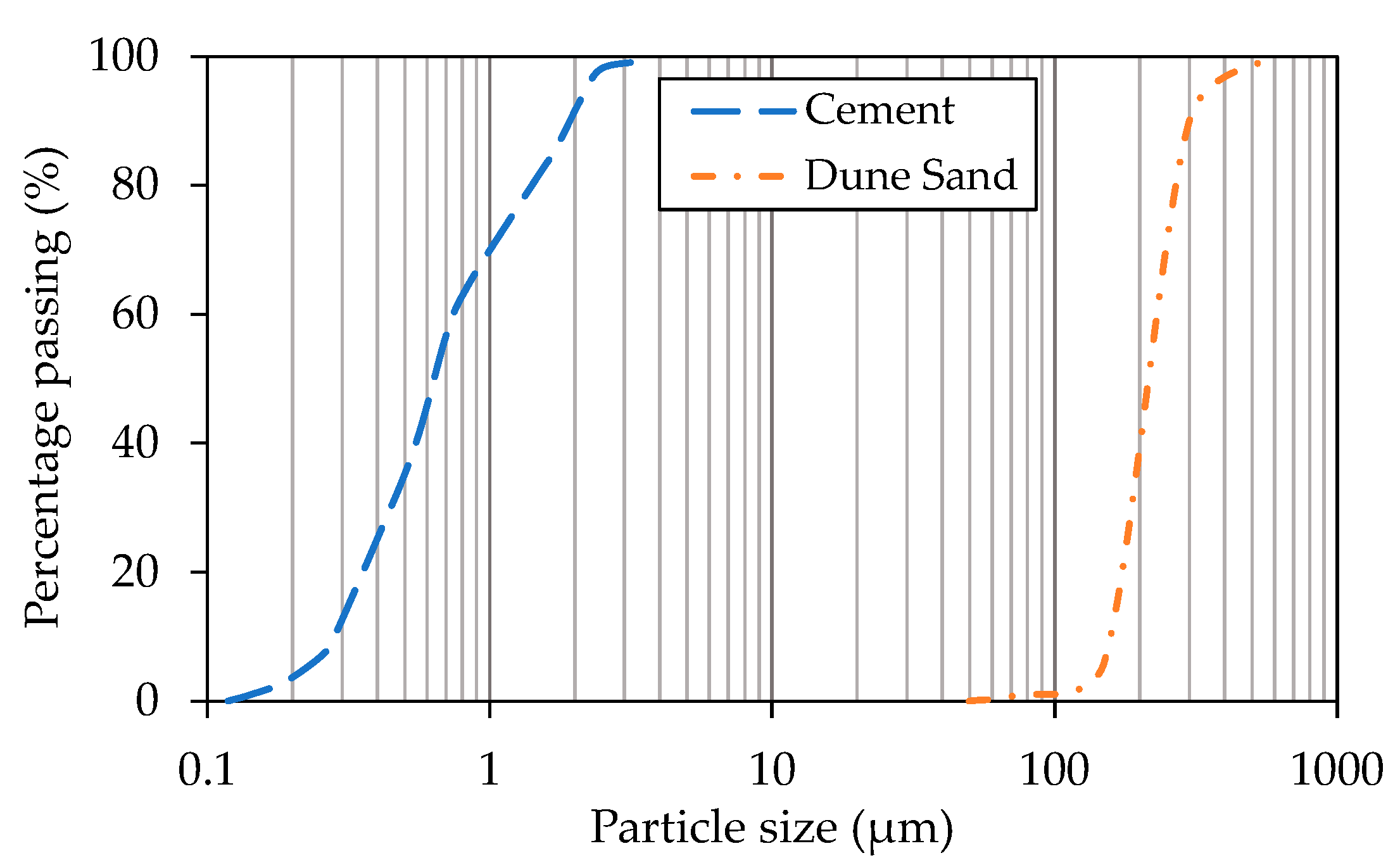


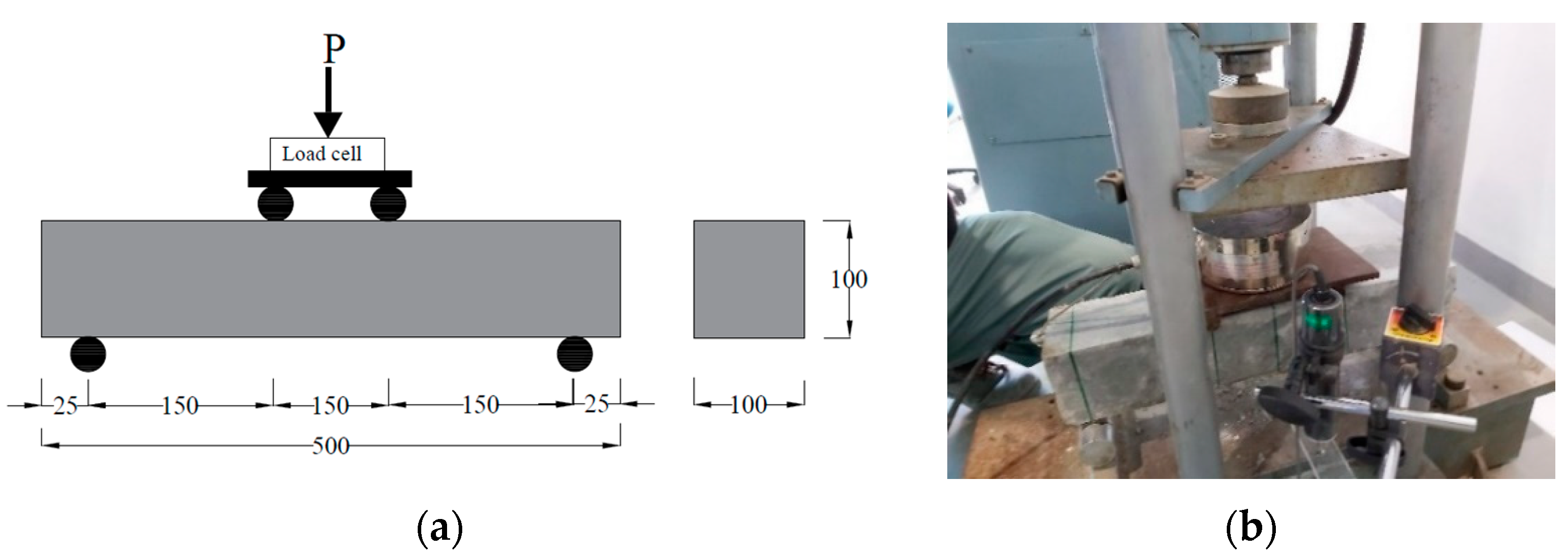

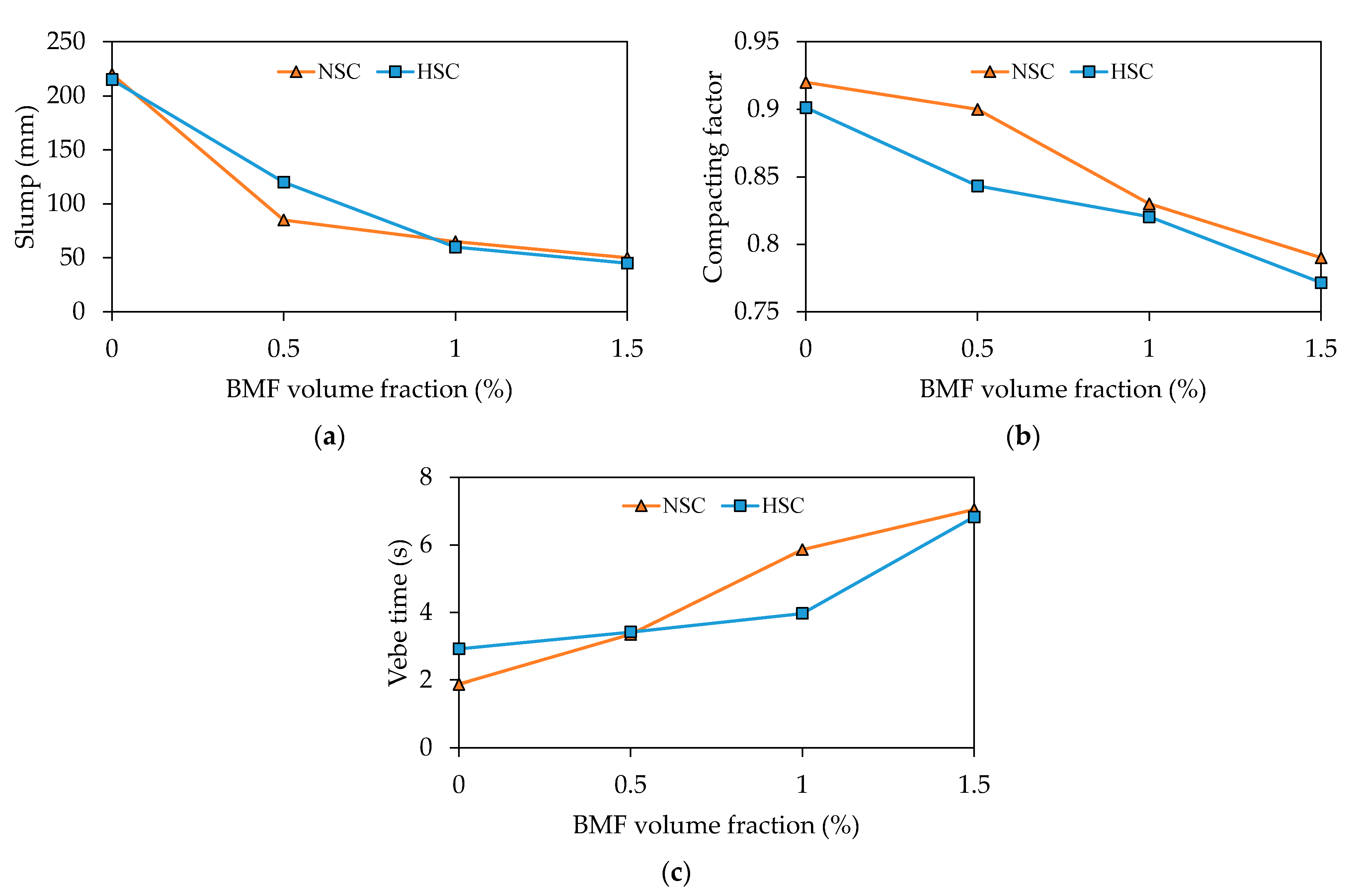




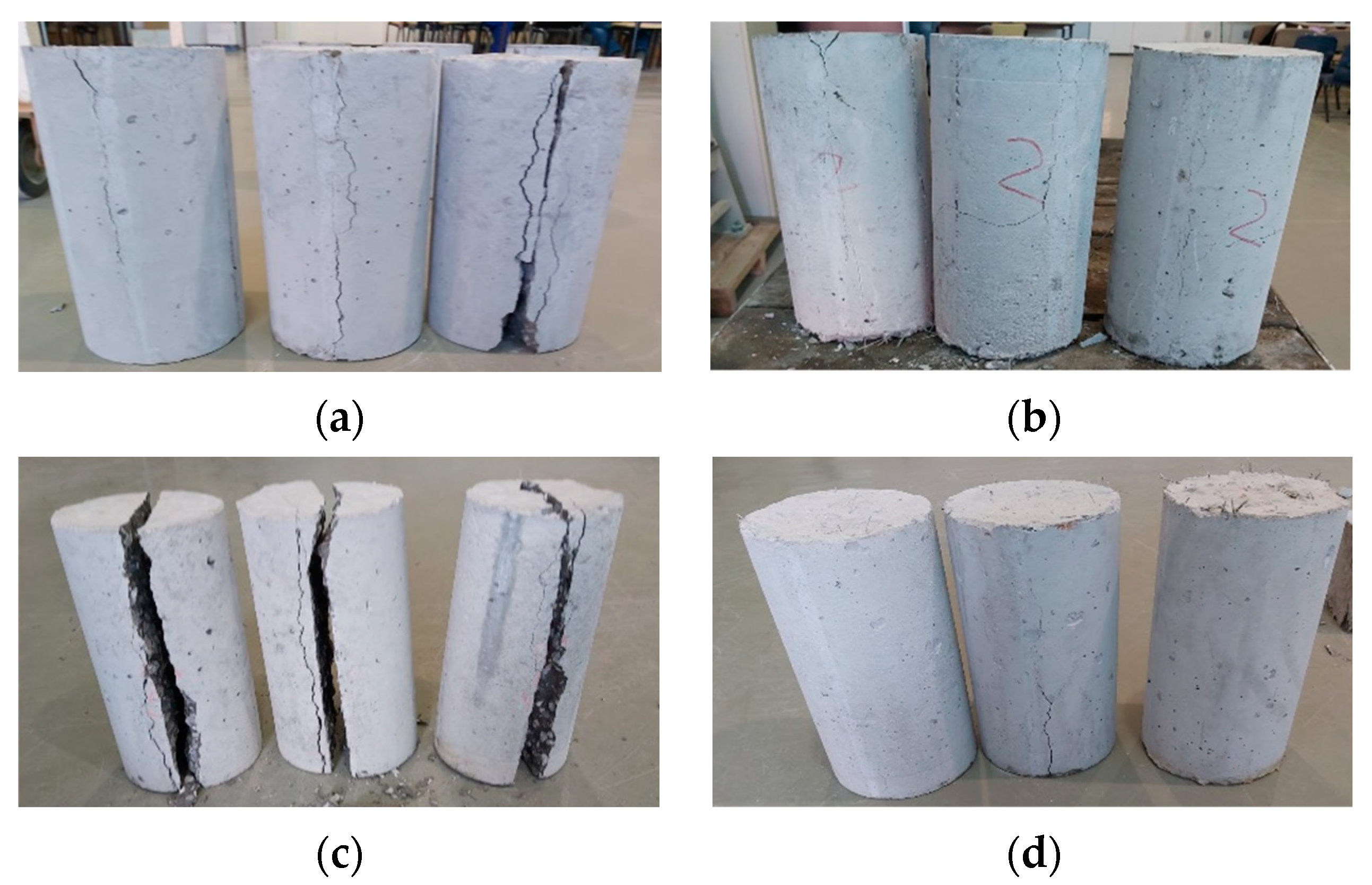


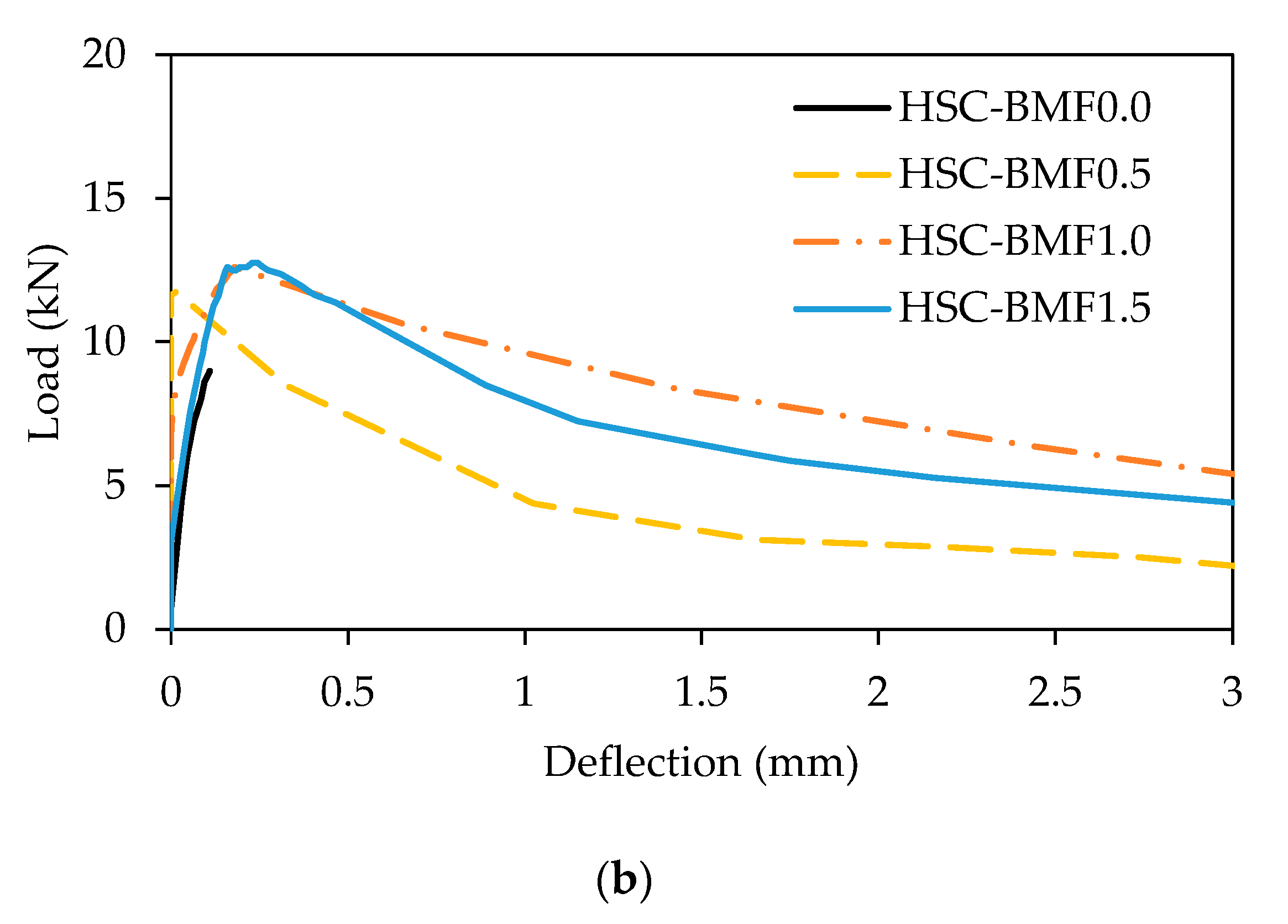


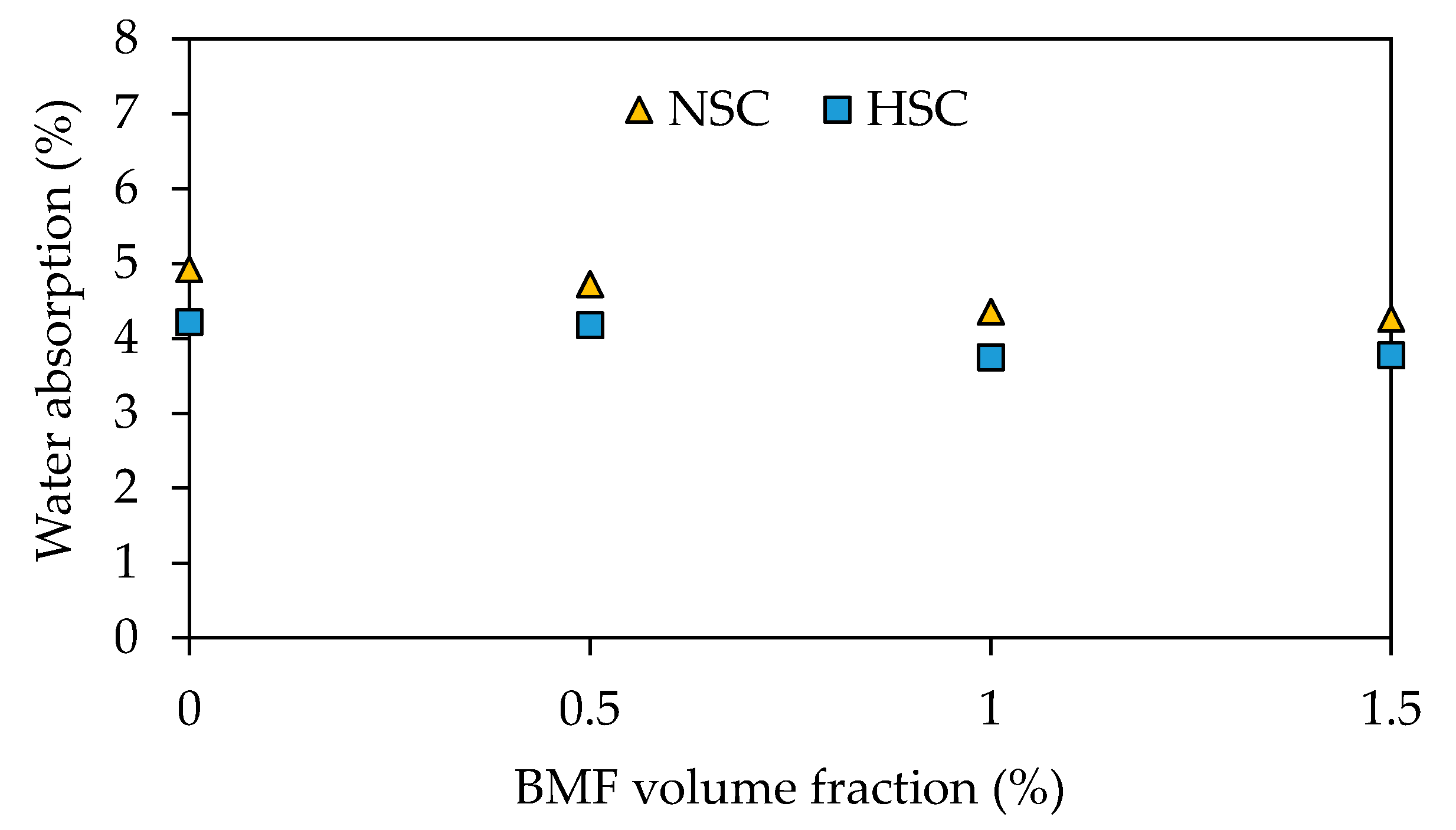
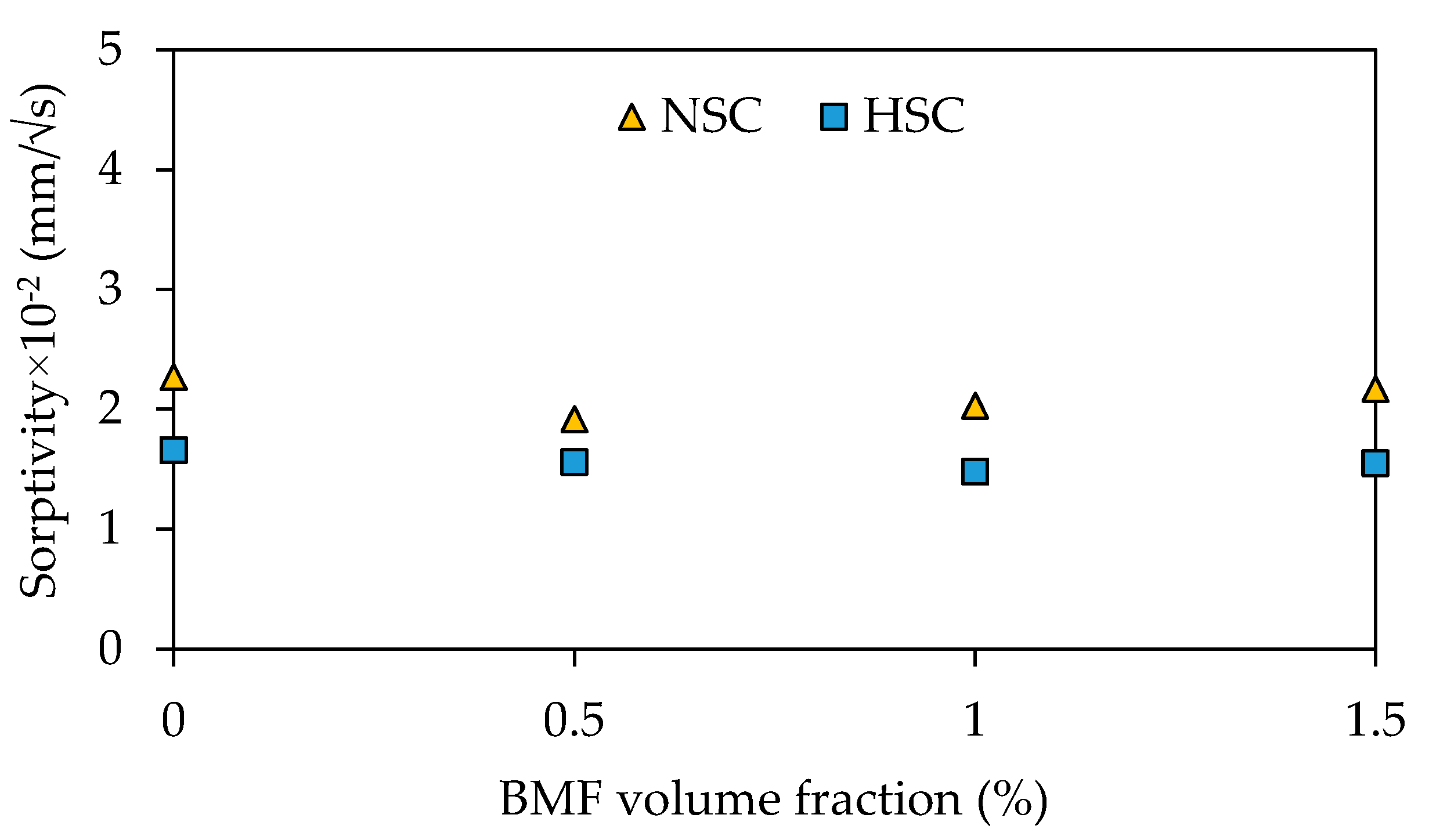

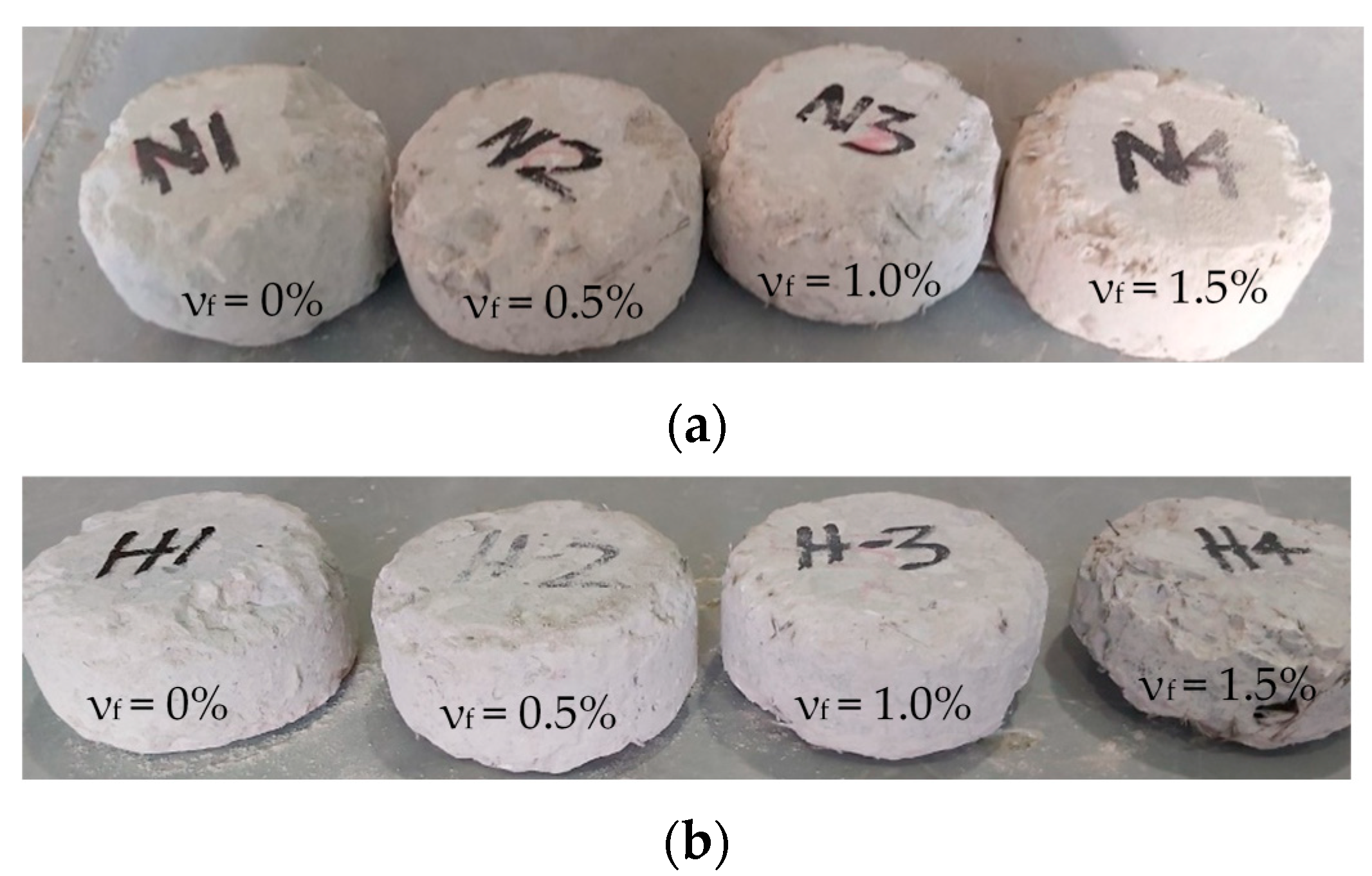

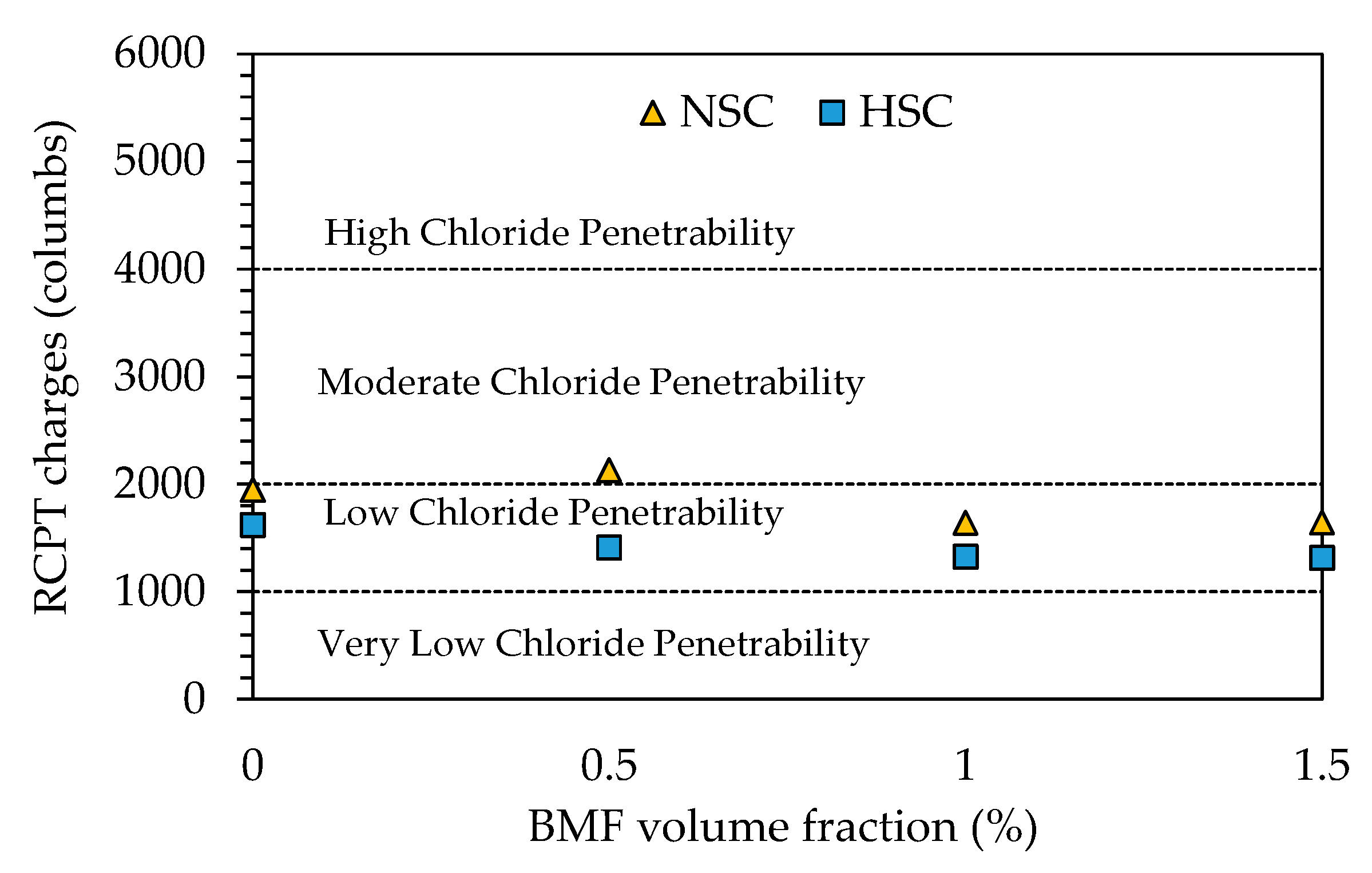





| Group | Mix ID | BMF Volume Fraction νf (%) |
|---|---|---|
| NSC | NSC-BMF0.0 | 0.0 |
| NSC-BMF0.5 | 0.5 | |
| NSC-BMF1.0 | 1.0 | |
| NSC-BMF1.5 | 1.5 | |
| HSC | HSC-BMF0.0 | 0.0 |
| HSC-BMF0.5 | 0.5 | |
| HSC-BMF1.0 | 1.0 | |
| HSC-BMF1.5 | 1.5 |
| Property | Unit | ASTM Standard | CA | Dune Sand |
|---|---|---|---|---|
| Absorption | % | C127 [27] | 0.40 | - |
| Specific gravity | - | C127 [27] | 2.82 | 2.77 |
| Fineness modulus | - | C136 [28] | 6.82 | 1.45 |
| Surface area | cm2/g | C136 [28] | 2.49 | 116.80 |
| Soundness (MgSO4) | % | C88 [29] | 1.20 | - |
| Los Angeles abrasion | % | C131 [30] | 16.00 | - |
| Dry-rodded density | kg/m3 | C29 [31] | 1635.00 | 1663.00 |
| Property | Value |
|---|---|
| Length (mm) | 43.00 |
| Diameter (mm) | 0.72 |
| Length/diameter ratio | 60.00 |
| Density (g/cm3) | 2.10 |
| Elastic modulus (GPa) | 44.00 |
| Tensile strength (MPa) | 900.00 |
| Color | Black |
| Group | Mix ID | Mass (kg/m3) | |||||
|---|---|---|---|---|---|---|---|
| DS | CA | Cement | Water | SP | BMF | ||
| NSC | NSC-BMF0.0 | 659 | 1080 | 470 | 230 | 0.47 | 0.0 |
| NSC-BMF0.5 | 659 | 1080 | 470 | 230 | 0.47 | 10.5 | |
| NSC-BMF1.0 | 659 | 1080 | 470 | 230 | 0.47 | 21 | |
| NSC-BMF1.5 | 659 | 1080 | 470 | 230 | 0.47 | 31.5 | |
| HSC | HSC-BMF0.0 | 513 | 1079 | 617 | 216 | 0.92 | 0.0 |
| HSC-BMF0.5 | 513 | 1079 | 617 | 216 | 0.92 | 10.5 | |
| HSC-BMF1.0 | 513 | 1079 | 617 | 216 | 0.92 | 21 | |
| HSC-BMF1.5 | 513 | 1079 | 617 | 216 | 0.92 | 31.5 | |
| Category | Property | Test Standard | Specimen Type | Specimen Dimension | No. of Replicates |
|---|---|---|---|---|---|
| Fresh | Slump | ASTM C143 [34] | - | - | 1 |
| Compacting factor | BS EN 12350-4:2019 [35] | - | - | 1 | |
| Vebe time | BS EN 12350-3:2019 [36] | - | - | 1 | |
| Mechanical | Cube compressive strength | BS EN 12390-3:2019 [37] | Cube | 150 × 150 mm | 5 |
| Cylinder compressive strength | ASTM C39 [38] | Cylinder | 150Φ × 300 mm | 5 | |
| Elastic modulus | ASTM C469 [39] | Cylinder | 150Φ × 300 mm | 1 | |
| Splitting tensile strength | ASTM C496 [40] | Cylinder | 150Φ × 300 mm | 3 | |
| Flexural strength | ASTM C1609 [41] | Prism | 100 × 100 × 500 mm | 3 | |
| Durability | Water absorption | ASTM C642 [42] | Disc | 100Φ × 50 mm | 3 |
| Sorptivity | ASTM C1585 [43] | Disc | 100Φ × 50 mm | 1 | |
| Los Angeles abrasion | ASTM C 1747 [44] | Disc | 100Φ × 50 mm | 3 | |
| Bulk resistivity | ASTM C1760 [45] | Cylinder | 100Φ × 200 mm | 1 | |
| Rapid chloride penetration | ASTM C1202 [46] | Disc | 100Φ × 50 mm | 3 | |
| Ultrasonic pulse velocity | ASTM C597 [47] | Cube | 150 × 150 mm | 1 |
| Group | Mix ID | BMF (%) | Slump (mm) | Compacting Factor | Vebe Time (s) |
|---|---|---|---|---|---|
| NSC | NSC-BMF0.0 | 0.0 | 220 | 0.92 | 1.88 |
| NSC-BMF 0.5 | 0.5 | 85 | 0.90 | 3.35 | |
| NSC-BMF 1.0 | 1.0 | 65 | 0.83 | 5.86 | |
| NSC-BMF 1.5 | 1.5 | 50 | 0.79 | 7.05 | |
| HSC | HSC-BMF 0.0 | 0.0 | 215 | 0.90 | 2.92 |
| HSC-BMF 0.5 | 0.5 | 120 | 0.84 | 3.42 | |
| HSC-BMF 1.0 | 1.0 | 60 | 0.82 | 3.97 | |
| HSC-BMF 1.5 | 1.5 | 45 | 0.77 | 6.83 |
| Group | Mix ID | BMF (%) | fcu (MPa) | f’c (MPa) | f’c/fcu | Ec (GPa) | fsp (MPa) | fr (MPa) | fsp/fr |
|---|---|---|---|---|---|---|---|---|---|
| NSC | NSC-BMF0.0 | 0.0 | 40.0 (1.20) | 36.5 (1.73) | 0.91 | 35.6 | 2.39 (0.17) | 3.82 (0.08) | 0.62 |
| NSC-BMF0.5 | 0.5 | 40.5 (2.37) | 37.7 (1.69) | 0.93 | 34.9 | 2.62 (0.19) | 4.52 (0.20) | 0.58 | |
| NSC-BMF1.0 | 1.0 | 42.1 (2.09) | 38.0 (0.68) | 0.90 | 34.7 | 2.97 (0.15) | 4.75 (0.04) | 0.62 | |
| NSC-BMF1.5 | 1.5 | 41.3 (0.74) | 37.9 (1.58) | 0.92 | 36.9 | 3.62 (0.04) | 5.96 (0.32) | 0.61 | |
| HSC | HSC-BMF0.0 | 0.0 | 58.6 (0.81) | 53.6 (2.15) | 0.91 | 41.9 | 3.62 (0.17) | 4.50 (0.60) | 0.80 |
| HSC-BMF0.5 | 0.5 | 53.7 (0.58) | 48.3 (3.57) | 0.90 | 40.7 | 3.73 (0.10) | 5.15 (0.14) | 0.73 | |
| HSC-BMF1.0 | 1.0 | 58.5 (0.92) | 49.9 (1.82) | 0.85 | 42.0 | 3.99 (0.24) | 5.36 (1.02) | 0.74 | |
| HSC-BMF1.5 | 1.5 | 56.7 (0.96) | 49.5 (3.61) | 0.87 | 36.6 | 4.43 (0.40) | 5.62 (0.16) | 0.79 |
| Group | Mix ID | Pmax (kN) | fr (MPa) | 𝛿p (mm) | f600100 (MPa) | f150100 (MPa) | T150100 (J) |
|---|---|---|---|---|---|---|---|
| NSC | NSC-BMF0.0 | 8.49 (0.18) | 3.82 (0.08) | 0.05 (0.00) | - | - | - |
| NSC-BMF0.5 | 10.05 (0.44) | 4.52 (0.20) | 0.05 (0.00) | 2.87 (0.08) | 0.93 (0.30) | 14.07 (1.39) | |
| NSC-BMF1.0 | 10.55 (0.08) | 4.75 (0.04) | 0.16 (0.01) | 3.64 (0.21) | 1.67 (0.03) | 19.38 (0.75) | |
| NSC-BMF1.5 | 13.24 (0.71) | 5.96 (0.32) | 0.36 (0.06) | 5.73 (0.27) | 3.67 (0.41) | 33.15 (0.14) | |
| HSC | HSC-BMF0.0 | 9.99 (1.32) | 4.50 (0.60) | 0.11 (0.03) | - | - | - |
| HSC-BMF0.5 | 11.45 (0.32) | 5.15 (0.14) | 0.11 (0.13) | 2.96 (0.34) | 0.95 (0.06) | 14.16 (0.40) | |
| HSC-BMF1.0 | 11.90 (2.27) | 5.36 (1.02) | 0.13 (0.07) | 3.70 (1.45) | 1.57 (0.76) | 19.45 (7.71) | |
| HSC-BMF1.5 | 12.49 (0.35) | 5.62 (0.16) | 0.38 (0.16) | 4.65 (1.96) | 2.23 (0.90) | 23.69 (3.26) |
| Group | Mixture ID | BMF (%) | Water Absorption (%) | Sorptivity × 10−2 (mm/) |
|---|---|---|---|---|
| NSC | NSC-BMF0.0 | 0.0 | 4.93 | 2.27 |
| NSC-BMF0.5 | 0.5 | 4.73 | 1.92 | |
| NSC-BMF1.0 | 1.0 | 4.36 | 2.03 | |
| NSC-BMF1.5 | 1.5 | 4.27 | 2.17 | |
| HSC | HSC-BMF0.0 | 0.0 | 4.22 | 1.66 |
| HSC-BMF0.5 | 0.5 | 4.18 | 1.56 | |
| HSC-BMF1.0 | 1.0 | 3.75 | 1.48 | |
| HSC-BMF1.5 | 1.5 | 3.77 | 1.55 |
| Group | Mixture ID | BMF (%) | Abrasion Mass Loss (%) | Bulk Resistivity (kΩ·cm) | RCPT (Columbus) |
|---|---|---|---|---|---|
| NSC | NSC-BMF0.0 | 0.0 | 14.2 | 6.8 | 1949 |
| NSC-BMF0.5 | 0.5 | 11.8 | 7.2 | 2134 | |
| NSC-BMF1.0 | 1 | 11.2 | 7.6 | 1642 | |
| NSC-BMF1.5 | 1.5 | 10.4 | 8.2 | 1647 | |
| HSC | HSC-MBF0.0 | 0.0 | 8.3 | 7.4 | 1621 |
| HSC-MBF0.5 | 0.5 | 8.1 | 7.6 | 1413 | |
| HSC-MBF1.0 | 1 | 8.1 | 8.3 | 1327 | |
| HSC-MBF1.5 | 1.5 | 8.0 | 8.7 | 1314 |
| Mixture ID | Load Capacity (kN) | Toughness (J) | Error 1 (%) | |||
|---|---|---|---|---|---|---|
| Experimental | Numerical | Experimental | Numerical | Load Capacity | Toughness | |
| NSC-BMF0.5 | 10.05 | 11.47 | 14.07 | 16.22 | 14.15 | 15.28 |
| NSC-BMF1.0 | 10.55 | 11.90 | 19.38 | 18.76 | 12.82 | 3.19 |
| NSC-BMF1.5 | 13.24 | 14.72 | 33.15 | 26.42 | 11.15 | 20.3 |
| HSC-BMF0.5 | 11.45 | 13.13 | 14.16 | 18.46 | 14.66 | 30.39 |
| HSC-BMF1.0 | 11.90 | 13.64 | 19.45 | 21.42 | 14.64 | 10.11 |
| HSC-BMF1.5 | 12.49 | 14.06 | 23.69 | 24.40 | 12.54 | 2.98 |
| Average | 13.33 | 13.71 | ||||
Publisher’s Note: MDPI stays neutral with regard to jurisdictional claims in published maps and institutional affiliations. |
© 2022 by the authors. Licensee MDPI, Basel, Switzerland. This article is an open access article distributed under the terms and conditions of the Creative Commons Attribution (CC BY) license (https://creativecommons.org/licenses/by/4.0/).
Share and Cite
Shoaib, S.; El-Maaddawy, T.; El-Hassan, H.; El-Ariss, B.; Alsalami, M. Fresh and Hardened Properties of Concrete Reinforced with Basalt Macro-Fibers. Buildings 2022, 12, 1136. https://doi.org/10.3390/buildings12081136
Shoaib S, El-Maaddawy T, El-Hassan H, El-Ariss B, Alsalami M. Fresh and Hardened Properties of Concrete Reinforced with Basalt Macro-Fibers. Buildings. 2022; 12(8):1136. https://doi.org/10.3390/buildings12081136
Chicago/Turabian StyleShoaib, Shahrukh, Tamer El-Maaddawy, Hilal El-Hassan, Bilal El-Ariss, and Marwa Alsalami. 2022. "Fresh and Hardened Properties of Concrete Reinforced with Basalt Macro-Fibers" Buildings 12, no. 8: 1136. https://doi.org/10.3390/buildings12081136







